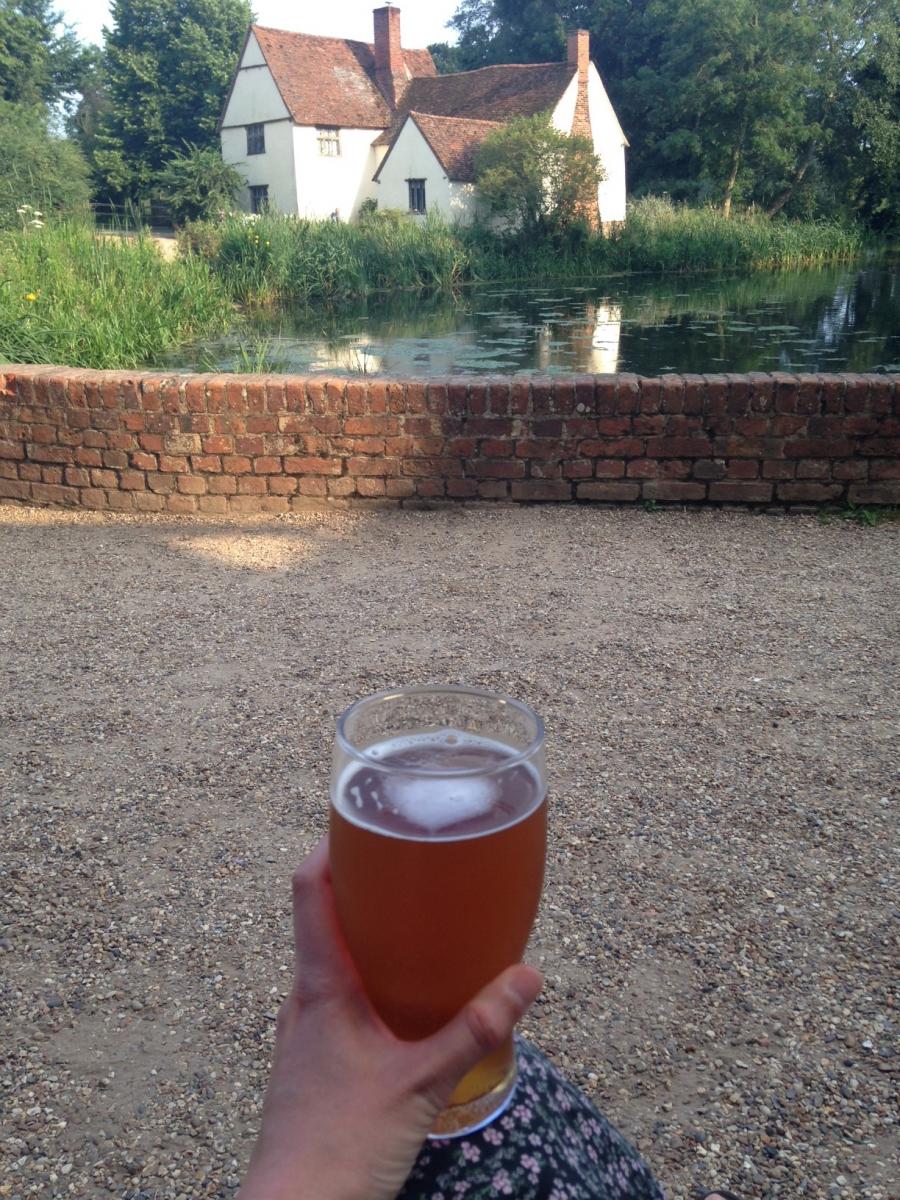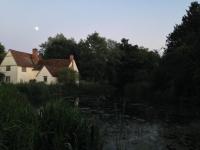Solitary bee week - a review
As we've all had cause to observe lately, a week is a long time in politics. But not, it turns out, when learning about solitary bees...
 I spent last week in Suffolk, in the absolutely idyllic surroundings of FSC Flatford Mill. My reason for being there was a new week-long Solitary Bee course run by Ian Cheeseborough and Bex Cartwright. The course arose partly due to popular demand for a longer course on this subject, and was supported financially by Tom.bio – we provided bursaries to reduce the cost of the course for attendees. One of the reasons Tom.bio got involved was our curiosity about the popularity and viability of a week-long course – in recent years the trend has been a move away from longer courses towards shorter courses, such as one day courses or weekends. A Friday-to-Friday course is now a pretty rare thing to find on offer at an FSC centre.
I spent last week in Suffolk, in the absolutely idyllic surroundings of FSC Flatford Mill. My reason for being there was a new week-long Solitary Bee course run by Ian Cheeseborough and Bex Cartwright. The course arose partly due to popular demand for a longer course on this subject, and was supported financially by Tom.bio – we provided bursaries to reduce the cost of the course for attendees. One of the reasons Tom.bio got involved was our curiosity about the popularity and viability of a week-long course – in recent years the trend has been a move away from longer courses towards shorter courses, such as one day courses or weekends. A Friday-to-Friday course is now a pretty rare thing to find on offer at an FSC centre.
 As a complete beginner to solitary bees I was slightly apprehensive about immersing myself in a new topic for a whole week. I needn’t have worried! From the first moment I was fascinated by this group of species – I spend much of my recording life looking at earthworms and springtails which, although fascinating and very important, are rarely breathtakingly beautiful. Unlike bees! As with any taxonomic group there is a new vocabulary to learn in terms of anatomy and adjectives, but there’s certainly some overlap with other groups I’ve studied which made learning the language of bee a little easier. Ian and Bex were great teachers too, adapting to the varying needs and levels of experience amongst the class (and being very patient with those of us who were less experienced!).
As a complete beginner to solitary bees I was slightly apprehensive about immersing myself in a new topic for a whole week. I needn’t have worried! From the first moment I was fascinated by this group of species – I spend much of my recording life looking at earthworms and springtails which, although fascinating and very important, are rarely breathtakingly beautiful. Unlike bees! As with any taxonomic group there is a new vocabulary to learn in terms of anatomy and adjectives, but there’s certainly some overlap with other groups I’ve studied which made learning the language of bee a little easier. Ian and Bex were great teachers too, adapting to the varying needs and levels of experience amongst the class (and being very patient with those of us who were less experienced!).
 Although I was definitely the least experienced 'bee person' in the room I felt immediately at home with the other people in the group – the regular banter became a feature of the week and definitely made it feel more like fun than work! In my mind this social side of the course was a real plus of the seven day format – we all got to know each other well and bonded as a group – I definitely feel like I’ve made some good friends who I’ll keep in touch with.
Although I was definitely the least experienced 'bee person' in the room I felt immediately at home with the other people in the group – the regular banter became a feature of the week and definitely made it feel more like fun than work! In my mind this social side of the course was a real plus of the seven day format – we all got to know each other well and bonded as a group – I definitely feel like I’ve made some good friends who I’ll keep in touch with.
 An important aspect of the course for me was the fieldwork, especially during such a glorious week of almost unbroken sunshine. No-one – however much they enjoyed keying out their bees – could bear to be inside all day, especially in such lovely surroundings. We had two official fieldtrips – to Westleton Heath and Fingringhoe Wick (both fantastic sites for bees), but on the other days we broke up the classroom sessions with regular walks around the grounds and local area, looking for bees and learning field craft and field ID – by the end of the week I felt able to have a go at identifying bees to family or genus in the field. Although this doesn’t sound much, to me, starting from zero knowledge about solitary bees, that feels like a big achievement!
An important aspect of the course for me was the fieldwork, especially during such a glorious week of almost unbroken sunshine. No-one – however much they enjoyed keying out their bees – could bear to be inside all day, especially in such lovely surroundings. We had two official fieldtrips – to Westleton Heath and Fingringhoe Wick (both fantastic sites for bees), but on the other days we broke up the classroom sessions with regular walks around the grounds and local area, looking for bees and learning field craft and field ID – by the end of the week I felt able to have a go at identifying bees to family or genus in the field. Although this doesn’t sound much, to me, starting from zero knowledge about solitary bees, that feels like a big achievement!
I’m always struck by how my view of the environment changes with every new group of species I become interested in. I started as a birder, spending most of the time looking upwards and listening for songs and calls. Now when I’m looking for earthworms and other soil inverts, I look downwards and my ‘search image’ is for dead, rotting wood, large stones, or anything else under which they might lurk. During this course, I learned a bit more about how to look for bees – thankfully, eye-height seems not a bad place to start looking! I learnt how to read the landscape for the three key things Ian explained that bees need: suitable forage habitat, suitable nest sites, and suitable nesting material. It’s there where you’ll find your bees!
 The classroom sessions revolved around the brilliant new bee key by Steven Falk, illustrated by Richard Lewington. We focussed on one or two families per day, learning about their behaviour, associations and habitat, and the key features used to ID them to species. After the presentations, we then used reference collections to key out specimens to species using the keys in the book. My method of choice was to pick a specimen ‘blind’, key it out and then check my answer against the label. I didn’t always (ahem!) get it right first time, but making mistakes is all part of the learning process! It’s definitely not easy – a lot of the couplets are comparative (‘bigger than…’, ‘shorter than…’, ‘more punctured than…’ etc), which for a beginner who lacks experience is quite tricky, and makes having a reference collection to hand invaluable. But, on the whole, the new key is great; very engaging and easy to follow for a relative novice.
The classroom sessions revolved around the brilliant new bee key by Steven Falk, illustrated by Richard Lewington. We focussed on one or two families per day, learning about their behaviour, associations and habitat, and the key features used to ID them to species. After the presentations, we then used reference collections to key out specimens to species using the keys in the book. My method of choice was to pick a specimen ‘blind’, key it out and then check my answer against the label. I didn’t always (ahem!) get it right first time, but making mistakes is all part of the learning process! It’s definitely not easy – a lot of the couplets are comparative (‘bigger than…’, ‘shorter than…’, ‘more punctured than…’ etc), which for a beginner who lacks experience is quite tricky, and makes having a reference collection to hand invaluable. But, on the whole, the new key is great; very engaging and easy to follow for a relative novice.
 Some of my favourite bees were the Nomada group – quite waspy looking, many with shiny colourful abdomens like boiled sweets. Their behaviour is fascinating. They’re cleptoparasites, breaking into the nests of other solitary bee species and laying their own eggs, the larvae of which then eat the original larvae and the provisions stored for it. I also like the Coelioxys, or ‘pointy bum bees’ - lovely looking things.
Some of my favourite bees were the Nomada group – quite waspy looking, many with shiny colourful abdomens like boiled sweets. Their behaviour is fascinating. They’re cleptoparasites, breaking into the nests of other solitary bee species and laying their own eggs, the larvae of which then eat the original larvae and the provisions stored for it. I also like the Coelioxys, or ‘pointy bum bees’ - lovely looking things.
Although bees were the main event, we also had other wildlife highlights – antlions, bee-wolf, barn owls, little owls, turtle doves, willow emerald damselfly. And lots of solitary wasps, which in themselves are fascinating and beautiful group – although maybe I’ll save those for another day.
 As we approached the middle and then the latter part of the week, I started to hear more and more comments about how ‘a week is just not long enough’. By the end of the week I was joining in with them – I certainly didn’t feel ready to leave the ‘bee bubble’, the company of like-minded people or the gorgeous landscape around Flatford. We all agreed that a full week allowed us to completely immerse ourselves in the subject, and each day reinforced the previous day’s learning. Another advantage of a week-long course is the freedom to take a break from the microscopes every now and then – on a shorter course, there’s a certain amount of pressure to maximise every minute, but having seven 12-hour days at your disposal means that a sneaky ice-cream at the National Trust tea rooms up the lane doesn’t feel quite so sneaky!
As we approached the middle and then the latter part of the week, I started to hear more and more comments about how ‘a week is just not long enough’. By the end of the week I was joining in with them – I certainly didn’t feel ready to leave the ‘bee bubble’, the company of like-minded people or the gorgeous landscape around Flatford. We all agreed that a full week allowed us to completely immerse ourselves in the subject, and each day reinforced the previous day’s learning. Another advantage of a week-long course is the freedom to take a break from the microscopes every now and then – on a shorter course, there’s a certain amount of pressure to maximise every minute, but having seven 12-hour days at your disposal means that a sneaky ice-cream at the National Trust tea rooms up the lane doesn’t feel quite so sneaky!
All in all a brilliant week. The only complaint – a week is not long enough! Bring on next year.
- Anonymous's blog
- Log in or register to post comments





